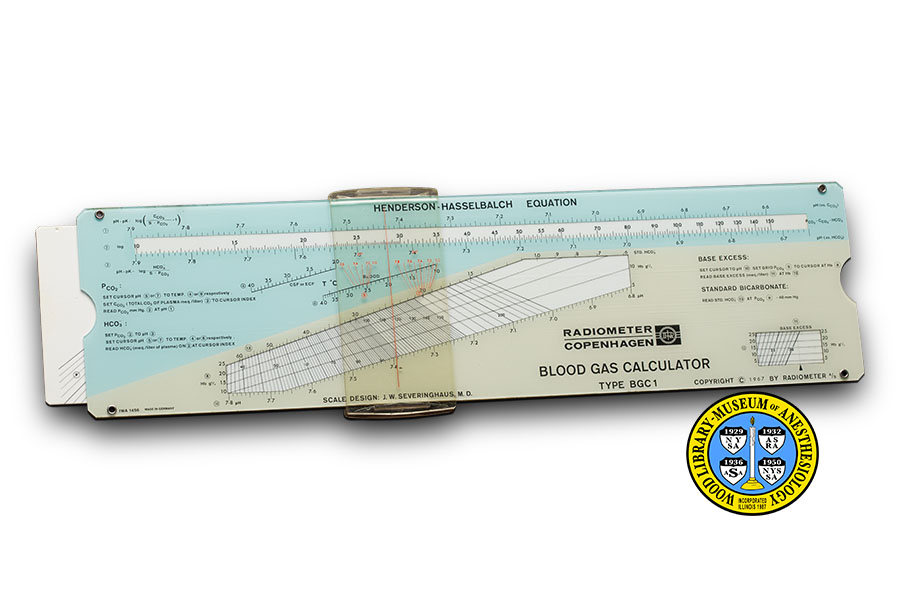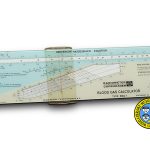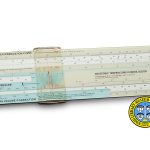Radiometer Blood Gas Calculator
American anesthesiologist and inventor, John W. Severinghaus, M.D. (born 1922), has long been recognized as an authority in the study of the interactions between respiration, blood gases and anesthesia. In the late 1950s, he designed the first multiple-function blood gas monitors. In 1964 and 1965, he pursued his research in Copenhagen, Denmark. With help from his colleagues there, he designed a slide rule that can be used to make several different blood gas computations. That slide rule was made in Copenhagen by Radiometer, a leading manufacturer of blood gas monitoring equipment.
The calculator was first produced in 1965, and continued in common use through the 1970s. Its features include scales and grids for determining the oxygen dissociation curve, the relationship between the arterial partial pressure of oxygen (abbreviated PaO2), and the extent to which arterial blood is saturated with oxygen (abbreviated SPO2), the arterial partial pressure of carbon dioxide (abbreviated PCO2), oxygen consumption and the respiratory exchange rate, changes in blood temperature, and more. In contrast, the Nunn Predictor, introduced just a few years earlier, computed only PO2 and PCO2. Both of these devices were outmoded by improved blood gas monitors.
Catalog Record: Radiometer Blood Gas Calculator Access Key: apoj
Accession No.: 1999-11-09-2 A
Title: Blood gas calculator / Radiometer.
Author: Severinghaus, John W. (Wendell), 1922-
Corporate Author: Radiometer.
Publisher: Copenhagen: Radiometer, [between 1967 and 1980?].
Physical Description: 1 slide rule : plastics, metal; 1 x 54 x 8.5 cm.
Subject: Blood Gas Analysis – instrumentation.
Web Link: https://www.woodlibrarymuseum.org/museum/item/1061/radiometer-blood-gas-calculator
Note Type: General
Notes: The first year in the date range is based on the copyright date printed on the object. The second year in the date range is based on the results of a literature search; it is likely to have been manufactured somewhat earlier.
The front of the object is considered that side on which the names of the object, the manufacturer and the inventor appear. This side is also marked with the Henderson-Hasselbalch Equation scale.
The height given in the short description is that with the slide in place; the height of the sleeve alone is approximately .25 centimeter. The width given in the short description is the maximum extension of the rule, form either side of the sleeve, at which any mark on the rule aligns with any mark on the sleeve.
Note Type: Citation
Notes: Severinghaus JW. Methods of measurement of blood and gas carbon dioxide during anesthesia. Anesthesiology. 1960;21:717.
Note Type: Citation
Notes: Severinghaus JW. Blood Gas Calculator. Copenhagen: Radiometer, ND.
Note Type: Citation
Notes: Severinghaus, JW. “Gadgeteering for health care: The John W. Severinghaus Lecture on Translational Science.” Anesthesiology. April, 2009;110(4):721-728.
Note Type: Physical Description
Notes: One slide rule; This consists of three parts: an exterior sleeve, an interior rule and a transparent slide; All three parts are printed on both sides; The sleeve and the rule are printed in black, and the slide is printed in red; The transparent plastic slide moves freely over the length of the sleeve, and can be completely removed;
The rule can be moved freely to the left and right, and can be completely removed from the sleeve in either direction; With the rule fully inserted in the sleeve, the object measures 8.75 x 28.5 x 1 centimeter; The rule is made of a sheet of thin white plastic; The rule cannot be seen in its entirety while inserted (that is, the marks at the extreme left and extreme right cannot be seen unless the rule is fully removed from the sleeve); When removed, the interior rule measures 28.5 x 6.5 centimeters; The rule is marked on one side with three scales, and on the other with a single scale from which many lines radiate;
The front and back panels of the sleeve are connected by four metal grommets, one fastened at each corner; The front panel of the sleeve has three scales, for PCO2, HCO3 and Base Excess; The front top edge is marked at the top edge: “HENDERSON-HASSELBALCH EQUATION”; Roughly in the center, the front is marked “RADIOMETER [followed by the corporate logo] [new line] COPENHAGEN [new line] BLOOD GAS CALCULATOR [new line] TYPE BGC-1”; The front bottom edge is marked, from left to right: “IWA 1456 MADE IN GERMANY [new line] SCALE DESIGN BY J. W. SEVERINGHAUS, M.D.” [new line] Copyright [followed by the copyright symbol] 1967 BY RADIOMETER A/S”; The back panel of the sleeve is marked on the left, from top to bottom: “OXYGEN DISTRIBUTION CURVE”‘, “EXPIRED AIR”, and “GAS VOLUME CORRECTION”; Near the center, the back panel is marked “ANAEROBIC TEMPERATURE CHANGE, BLOOD”.
Note Type: Reproduction
Notes: Photographed by Mr. Steve Donisch, November 14, 2016.
Note Type: Acquisition
Notes: Gift of LeRoy Misuraca, M.D.
Note Type: Historical
Notes: Anesthesia affects the body’s ability to breathe normally, which can cause changes in the patient’s blood chemistry. Anesthesiologists monitor the gases in the patient’s breath and blood. American anesthesiologist and inventor, John W. Severinghaus (born 1922) has long been recognized as preeminent in the study of respiration and blood gases. In the 1960s, he participated in several studies of the effects of high altitudes on cerebrospinal fluid and blood gases. In 1964 and 1965, he took a sabbatical to pursue these and related questions in Copenhagen, Denmark. That work, he said, “inspired me to design a slide rule to make blood gas calculations” (2009, p. 725-726.)
While only his own name appears on the object, in his publications Severinghaus has credited his many collaborators in this design. To produce the device, he turned to the Copenhagen manufacturer, Radiometer, where his colleague, Poul B. Astrup, M.D. (1915-2000), was head of the laboratory.
Radiometer made the first commercial meter to determine the pH (the amount acidity or alkalinity) of liquids, and in response to the 1950s polio epidemic, Astrup had designed the first blood gas monitor.
The calculator has scales and grids for determining the Henderson-Haselbalch equation, the oxygen dissociation curve (the relationship between the arterial partial pressure of oxygen, abbreviated PO2, and the extent to which arterial blood is saturated with oxygen, abbreviated SPO2), changes in blood temperature, oxygen consumption and the respiratory exchange rate, the arterial partial pressure of carbon dioxide (abbreviated PCO2), the level of carbon dioxide which is in bicarbonate rather than gaseous form (abbreviated HCO3), base excess (the extent to which the blood is alkaline), and gas volume correction. In comparison, the Nunn blood gas calculator could compute only PO2 and PCO2. From the 1960s to the 1980s, equipment that could continuously monitor blood oxygenation became increasingly common. These were replaced, in turn, by transcutaneous pulse oximeters, which measure oxygen saturation (SpO2) rather than PO2.
An undated booklet published by Radiometer is illustrated with an example of the device that bears a 1965 copyright date. The same illustration appears in Severinghaus’ 1966 description of the device. The design of the cataloged object differs at several points from that of the example dated 1965. These differences appear to be matters of layout rather than content, with an important exception: the scale for gas volume correction is much larger in the cataloged object than in the earlier design.
Note Type: Exhibition
Notes: Selected for the WLM website.



